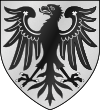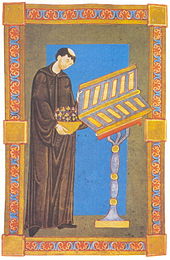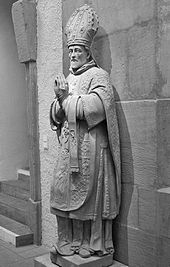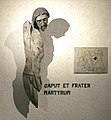Imperial Abbey of Echternach
|
Territory in the Holy Roman Empire |
|
|---|---|
| Imperial Abbey of Echternach | |
| coat of arms | |

|
|
| Ruler / government | Prince abbot |
| Today's region / s | LU-EC , DE-RP |
| Reich register | 2 horsemen, 18 foot soldiers, 100 guilders (1522) |
| Reichskreis | Lower Rhine-Westphalian |
| District council | Reichsfürstenrat : 1 curiate vote on the Rhine. Prelate database |
| Capitals / residences | Echternach |
| Denomination / Religions |
Roman Catholic
|
| Incorporated into | 1795: France 1815: Netherlands and Prussia
|
The Imperial Abbey of Echternach in the Luxembourg city of Echternach was a Benedictine monastery named St. Peter and Paul (previously collegiate monastery) and imperial territory in the Holy Roman Empire of the German Nation . In addition to large parts of the convent building, the reconstructed Basilica of St. Willibrord has been preserved from the monastery . The territory of the former Imperial Abbey of Echternach is now largely in the Federal Republic of Germany , and to a lesser extent in the Grand Duchy of Luxembourg and in the Kingdom of the Netherlands . The St. Willibrord basilica and large parts of the convent buildings are in Echternach. As a Free Imperial Abbey , it was imperial direct, possessed imperial territory and recognized only three lords, namely God, Pope and the Roman-German Emperor .
coat of arms
The coat of arms of the Imperial Abbey of Echternach shows, like almost all imperial territories in the Holy Roman Empire of the German Nation, the imperial eagle of the Holy Roman Empire of the German Nation .
history
The monastery was founded by the wandering monk and saint Willibrord in the 7th century on land given to Irmina von Oeren . When Irmina von Oeren transferred extensive goods to Willibrord and one half of Echternach with a church for the monastery at the end of the 7th century, it was already there. She described her foundation as a new establishment. A few days later, Pippin II. Willibrord transferred the other half of Echternach, which he had inherited from his ancestors. The Trinity, Mary and Peter and Paul appear as patrons. In 785, Charlemagne , who himself ran the monastery for a year, confirmed to Echternach the donation made by his brother Karlmann I (771) on the Lieser and in Bidgau . (Golden Book of the Echternach Abbey, today in the Gotha Research Library , signature "Memb. I 71"). It was probably the first Iro-Anglo-Saxon monastery on mainland Europe. The first works of the scriptorium, such as the “Willibrordus Evangeliar”, are richly decorated in the Irish style of the Celtic church, in whose tradition the Echternach monastery was located. In 751 Echternach became a royal Carolingian abbey . During the Saxony uprising of 782, the Bishop of Bremen, Willehad , stayed in the monastery for two years. From 847 to 973 lay abbots , members of the houses of Lorraine and Luxembourg , directed the community, which was probably constituted by a donation. Abbot Ravanger from the abbey St. Maximin in Trier was 973 at the instigation of Otto I the Benedictine rule introduced. The ties between Echternach and St. Maximin remained until the 17th century. It was expressed in the relics, the scriptorium, architecture as well as in prayer fraternities. After the abbey church burned down in 1016, the new abbey church was consecrated on October 19, 1031 by Archbishop Poppo of Trier . It was a Romanesque basilica , the dimensions of which corresponded to those of today's church. Wilhelm, the 21st Bishop of Utrecht, granted Abbot Reginbert von Echternach in a deed dated December 28, 1063 the right to dispose of half the income of several churches in Holland, including those of Leimuiden and the neighboring settlements of Woubrugge and Rijnsaterwoude . In the 11th century, the Codex aureus Epternacensis, the Codex Aureus Escorialensis or the Speyer Gospels were created in the Echternach scriptorium. The learned abbot Thiofried (1083–1110) von Echternach was the author of several source-based saints' lives and a work on the nature of relics. After the abbey church burned down in 1016, the new abbey church was consecrated on October 19, 1031 by Archbishop Poppo of Trier. Willibrord's bones were brought to the high altar, which is the first testimony to his admiration on site. The Willibrord cult was experienced at the end of the 13th century. a first climax. In 1148 Pope Eugene III confirmed . the abbot of Echternach owned Louvivelt, including the church and all accessories. This confirmation was renewed in 1161 by Pope Viktor IV . 1171-1210 Echternach was headed in personal union by abbots of St. Matthias who were close to Archbishop Arnold. During this time the Archbishop of Trier tried to incorporate the monastery into his monastery. The abbey reacted with the abbey history written by Theodoric (Liber aureus) and a memorandum and successfully defended itself. Since 1299 the abbots were also city lords of Echternach. Abbot Burchard Boswin von Neuerburg (1490–1506) introduced the Maximiner / Siegburg reform. Since 1562 there have been no more nobles as abbots. Abbot Antonius Hovaeus (1562–1568) Haecmundanus wrote several learned works and Abbot Johannes Bertels wrote a history of Luxembourg. Although the rich possessions in Friesland , the Willibrord mission area, were lost due to the introduction of the Reformation in the northern Netherlands, the abbey was still wealthy in more than 125 places in the 17th century. Up until the 18th century, however, it no longer received rich donations of Carolingian proportions. Abbot Matthias Hartz (1718–1728) began building the abbey buildings that were still there. Apparently because of the Willibrod cult and its independence, the monastery did not experience a decline like the Prüm Abbey . The last abbot Emmanuel Limpach of Echternach died on September 6th, 1793. There was no new abbot election. General Colaud entered Echternach on August 13, 1794 with the French revolutionary troops. The last monks of the monastery had fled earlier. The abbey was looted and Willibrord's grave was desecrated. The monastery and the monastery church were auctioned off in 1797. Jean-Henri Dondelinger , who eventually acquired it, set up the Faïencerie Dondelinger in the buildings . Around the middle of the 19th century, the choir of the basilica partially collapsed and it threatened to deteriorate completely. As a result, a church building association was founded in Echternach in 1862. In 1868 the restoration of the abbey church was completed in the spirit of neo-Romanesque and it could be re-consecrated. Since then it has been the parish church of Echternach, since 1939 with the rank of papal minor basilica .
Parts of the church were blown up during World War II. Grenade strikes destroyed what was left. A return to the Romanesque original was sought during the reconstruction. The tower facade was modeled on that of Paray-le-Monial . The re-consecration took place in 1953.
The Lycée classique d'Echternach with its attached boarding school is housed in parts of the former monastery .
Abbots
- Willibrord from Northumbria († November 7, 739, abbot 698–739), founder and 1st abbot
- Adalbert (739–775), 2nd Dept.
- Beornrad (Bernard de Sens) (775–797), 3rd abbot, 785 Archbishop of Sens
- Hetti (before 838–27 May 847), Archbishop of Trier
- Reginar (864–870), lay dept
- Adalhard I. (until 870), lay abbot
- Karlmann (874–876), son of Emperor Karl II. The Bald
- Adalhard II (until 890), lay abbot
- Hermann I of Swabia (926–949), lay abbot
- Siegfried I of Luxembourg (around 950), lay abbot
- Ravanger (Ravenger (ius)) (973-1007)
- Urold (us) (1007-1027)
- Humbert (us) (1028-1051)
- Reginbert (1051-1081)
- Theofried of Echternach (1081–1110)
- Godfried (Godefridus) I. (1122-1155)
- Ludwig (Ludovicus) (1173–1181), abbot of St. Matthias until 1188
- Godfried (Godefridus) II. (1181-1210)
- Bartholomäus von Esch (1210–1231)
- Richard I. (1270-1296) or (1280-1297)
- Heinrich von Schönecken (1298–1324)
- Theodoric von Are (1329-1341) 39th Abbot
- Johann (es) I of Winningen (1341–1353), 40th abbot
- Johann (es) II. Of Novavilla = Jean de Neuville (1353-1357), 41st abbot
- Wilhelm von Kerpen (Abbot 1358-1374), 42nd Abbot
- Hertwin von Waldeck (1375-1377), 43rd Dept.
- Philipp von Homburg (1377-1378)
- Wirich von Adenbach (1378–1400)
- Peter I. Beissel von Gymnich (1400–1412), 47th dept
- Nikolaus von Gymnich (1412–1418), 48th dept
- Peter II of Huebingen (Pierre de Hubines) (abbot 1418–1438), 49th abbot
- Winand von Gluwel (Wynant de Gluwel) (Abbot 1438–1465), 50th Abbot
- Colinus (Colin Plick von Oirwick) (Abbot 1465–1476), 51st Abbot
- Francis Plick von Oirwick (Abbot 1476–1477), 52nd Abbot
- Burchard Poszwin von Neuerburg (Burkard Posswyn, Burkhard Poissgen) (1490–1506), 54th Dept.
- Robert von Monreal (1506–1539), 55th dept
- Matthias von Lutzerath (Mathias de Lutzeradt) (1539), 56th Dept.
- Godfried (Gottfried, Godefridus) III. of Aspremont (Godefroid d'Aspremont) (1540–1562), 57th Dept.
- Antonius Hovaeus Haecmundanus (Antoon van Hove, Antoon (Antonius) van der Hoef von Egmond, French Antoine Hovay) († October 8, 1568, abbot 1563–1568), 59th abbot
- Martin Maas (Marten Maes a Meerbeeck, Martinus Masius) (1520–1585, abbot 1569–1585), 60th abbot
- Johann (es) III. Gladt (Jean Glatz) (abbot 1586–1594), 61st abbot
- Johann (es) IV. Bertels (1544–19 June 1607, abbot 1595–1607), 62nd abbot
- Peter III Richard (Pierre Richardot) = Petrus Richardotus (approx. 1575–1628, abbot 1607–1628), 63rd abbot
- Peter IV. (Pierre, Petrus) Fisch von Rosport († March 15, 1657, abbot 1628–1657), 64th abbot
- Richard II. Paschasius (1657–1667), 65th abbot
- Philippe de la Neufforge (Neuveforge, Neuforge) (May 8, 1621– September 10, 1684, 66th abbot 1667–1684), 66th abbot
- Willibrord Hotton (1684–1693), 67th Dept.
- Benedikt Zender (Benoît Zender) (1694–1717), 68th Dept.
- Matthias Hartz (1717–1728), 69th Dept.
- Gregor (ius) (Grégoire) Schouppe († July 19, 1751, abbot 1728–1751), 70th abbot
- Michael Hormann (1751–1775), 71st Dept.
- Emmanuel Limpach († September 6, 1793, abbot 1775–1793), 72nd abbot
- Prior Binsfeld
Monastery library and scriptorium
In the Middle Ages, Echternach was a center of illumination . The best-known works include the Golden Gospels of Echternach (Latin Codex Aureus Epternacensis, 11th century; today Germanisches Nationalmuseum Nürnberg ) and the Golden Gospel Book of Heinrich III. (Latin Codex Aureus Spirensis or Codex Aureus Escorialiensis, Speyer Gospels; today El Escorial , Madrid ).
The scriptorium of the Benedictine abbey is best known for its writings that were produced for export in the middle of the 11th century. A newly published catalog, on the other hand, includes theological, philosophical and educational manuscripts from the monastery library, which were only partly created in Echternach itself. 89 manuscripts, 154 fragments and 18 printed books from the 7th to the 17th centuries are described on almost 800 pages. For the first time, Thomas Falmagne examines the history of the monastery library, which appears to have been one of the largest in the West around the year 800 and shows Irish and southern European influences. Particularly noteworthy are a sheet of Pope Gregory I from the late 7th century, a tower of wisdom in a manuscript in the State Archives from the 15th century, an image of the abacus in the cover of the giant Bible or the Hisperica Famina fragments from the 9th century Century.
On February 9, 2010 the Bibliothèque nationale de Luxembourg publicly presented a catalog of the manuscripts, which is to be published in two volumes by Otto Harrassowitz Verlag, Wiesbaden.
organ
The organ of the abbey church was built in 1953 by the organ building company Johannes Klais (Bonn) and enlarged in 1991. The instrument has 74 stops , cone chests , four manuals and a pedal . The actions are electro-pneumatic. The trumpeteria can be individually coupled to all manuals and the pedal.
|
|
|
|
|
|||||||||||||||||||||||||||||||||||||||||||||||||||||||||||||||||||||||||||||||||||||||||||||||||||||||||||||||||||||||||||||||||||||||||||||||||||||||||||||||||
-
Pairing :
- Normal coupling: II / I, III / I, IV / I, I / II, III / II, IV / II, IV / III, I / P, II / P, III / P, IV / P
- Trumpeter connection: to all manuals and pedals
- Playing aids : 3 free combinations, a free pedal combination, tutti, 64-fold setting system , crescendo roller , various storage units.
Bells
In the towers of the basilica there are nine bells from two foundries. It is the deepest chime in Luxembourg.
| No. | Surname |
Nominal (16th note) |
Weight (kg) |
Diameter (mm) |
Casting year |
Caster |
| 1 | Willibrord | f 0 +8 | 6,985 | 2,215 | 2000 | Mark, D-Brockscheid |
| 2 | Benedict | as 0 +8 | 5,530 | 2,000 | 1999 | Mark, D-Brockscheid |
| 3 | Sebastian | b 0 +6 | 3,100 | 1,742 | 1948 | H. Rüetschi |
| 4th | Maria | of 1 +9 | 1,800 | 1,456 | 1948 | H. Rüetschi |
| 5 | Barbara | it 1 +3 | 1,300 | 1,320 | 1948 | H. Rüetschi |
| 6th | Wilgils | f 1 +7 | 920 | 1,160 | 1948 | H. Rüetschi |
| 7th | Irmina | as 1 +7 | 535 | 967 | 1948 | H. Rüetschi |
| 8th | Plectrudis | b 1 +5 | 385 | 874 | 1948 | H. Rüetschi |
| 9 | John | c 2 +6 | 355 | 781 | 1999 | Mark, D-Brockscheid |
Views
See also
literature
- Olaf Schneider: Archbishop Hinkmar and the consequences-The four hundred year journey of historical memory pictures from Reims to Trier . In: Millennium Studies 22. Verlag Walter de Gruyter , Berlin 2010
- Thomas Falmagne: The Echternach manuscripts up to 1628 in the holdings of the Bibliothèque nationale de Luxembourg: List of sources and references, introduction, images , Otto Harrassowitz Verlag, Wiesbaden 2009, pp. 507–508
- Camillus Wampach, History of the Echternach Manor in the Early Middle Ages, 2 vols. Luxembourg 1929/1930
- Carl Schorn, Eiflia Sacra, I. Bonn 1888, pp. 473-538
Web links
- Catholic Encyclopedia (English)
- Archdiocese of Luxembourg: The Echternach Basilica
- Daniel Erpelding: Heraldry, student history and others
- Germania Sacra - Monasteries and Abbey of the Old Kingdom - Benedictine Monastery of St. Peter and Paul, Echternach (previously collegiate monastery)
Individual evidence
- ↑ De goederen van de abdij Echternach in de Friese land ( Memento of 7 April 2014 Internet Archive )
- ^ Jacob Cornelis van Slee: Hovaeus, Antonius . In: Allgemeine Deutsche Biographie (ADB). Volume 13, Duncker & Humblot, Leipzig 1881, p. 213.
- ↑ See also letter from “A. H. H. A. E. ”(his abbreviation) to Johann Weyer on July 3, 1563; Johann Weyer: De praestigiis Daemonum , German edition Frankfurt am Main 1586, pp. 534–536 ( Google Books ); see. Frank Hieronymus (Ed.): Theophrast and Galen - Celsus and Paracelsus , Part 3 Medicine, Natural Philosophy, etc. from 1550 , Vol. IV. Nos. 464-620 . Verlag der Universitätsbibliothek, Basel 2005, p. 1775.
- ↑ Gerlinde NIEMEYER, 'The Origin of the Vita Willehadi', German Archive 12 (1956), 17–35, ibid. P. 32.
- ^ Historical-Politico-Geographical Atlas of the Whole World, Verlag Johann Samuel Heinsius, Leipzig 1745
- ^ Franz Xaver Kraus: Theofried . In: Allgemeine Deutsche Biographie (ADB). Volume 37, Duncker & Humblot, Leipzig 1894, p. 716 f.
- ↑ Petrus Becker OSB: The Benedictine Abbey of St. Eucharius-St. Matthias before Trier . In GERMANIA SACRA, NEW EPISODE 34 . Verlag Walter de Gruyter , Berlin 1996, p. 594
- ↑ Heimatjahrbuch Vulkaneifel 2004
- ^ Regesta Imperii XIII, no. 9 n. 197 - Regesta of Emperor Frederick III. (1440–1493)
- ↑ Blason in French.
- ^ Archives nationales de Luxembourg, ANLux A-XXIX-1297. Loutsch, Armorial du pays de Luxembourg, p. 360
- ^ Archives nationales de Luxembourg, ANLux A-XXIX-1297. Loutsch, Armorial du pays de Luxembourg, p. 634
- ^ Archives nationales de Luxembourg, ANLux A-XXIX-1297
- ^ Archives nationales de Luxembourg, ANLux A-XXIX-1297. Loutsch, Armorial du pays de Luxembourg, p. 446
- ^ Archives nationales de Luxembourg, ANLux A-XXIX-1297. Loutsch, Armorial du pays de Luxembourg, p. 835
- ^ Romain Hilgert: The rise and fall of a monastery library. ( Memento from May 25, 2014 in the Internet Archive ) d'Lëtzebuerger Land , February 26, 2010.
- ↑ Bibliothèque nationale de Luxembourg: Présentation du catalog des manuscrits d'Echternach. Government Communication February 10, 2010 ( Memento of March 8, 2012 in the Internet Archive )
- ↑ More information about the abbey organ ( memento from January 13, 2011 in the Internet Archive )
Coordinates: 49 ° 48 ′ 50 ″ N , 6 ° 25 ′ 21 ″ E













